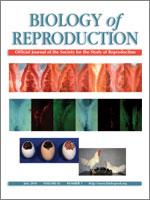Establishment and maintenance of pregnancy are critically dependent on embryo-maternal communication during the preimplantation period. To gain new insights into this complex process in the horse, transcriptional profiling of Day 13.5 pregnant and cyclic endometrial tissue samples was carried out using custom-designed microarrays. Selected array data were validated using quantitative RT-PCR, and proteins of interest were localized using immunohistochemistry. One hundred and six transcripts were up-regulated, whereas 47 transcripts showed lower expression levels in pregnant mares, that is, were down-regulated in pregnant mares. Half of the genes with known or inferred function are classically regulated by estrogens. Elevated transcript levels were found for genes involved in cell-cell signaling, heat shock response, and secretory proteins, among others. Solute carrier family 36 (proton/amino acid symporter), member 2, SLC36A2, was one of the most highly up-regulated genes, potentially reflecting the nutritional needs of the rapidly developing embryo. Among the genes showing lower expression in pregnant mares, estrogen receptor 1 was of particular interest because of its potential involvement in the initiation of luteolysis in cyclic mares. We hypothesize that either conceptus' estrogens or luteinizing hormone of uterine origin is involved in the observed down-regulation of estrogen receptor 1. Several of the genes identified in the current study are known to play a role in early pregnancy in species other than the horse. Thus, products of these commonly expressed genes likely contain universal activities for controlling endometrial receptivity to the conceptus, whereas other factors play unique roles within specific species in ensuring ongoing corpus luteum function. This is the first systematic study of endometrial transcriptome changes in response to the presence of an embryo during maternal recognition of pregnancy and an important step toward deciphering the embryo-maternal dialogue in equids.
How to translate text using browser tools
24 March 2010
Transcriptional Profiling of Equine Endometrium During the Time of Maternal Recognition of Pregnancy
Claudia Klein,
Kirsten E. Scoggin,
Alan D. Ealy,
Mats H.T. Troedsson
ACCESS THE FULL ARTICLE

Biology of Reproduction
Vol. 83 • No. 1
July 2010
Vol. 83 • No. 1
July 2010
conceptus
embryo-maternal interaction
estradiol receptor
estrogen receptor
gene regulation
microarray
pregnancy




